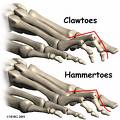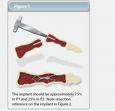Toe Deformities
What is a Hammer Toe?

The small toes can be pulled back on top of the foot by excessive pull of the toe tendons. This causes the joints to be prominent and shoes can cause painful pressure on the deformed toes. Sometimes this causes continually painful corns making walking very uncomfortable. If the pressure is extreme it can cause ulcers on the toes.
Small toes can be displaced from their normal alignment because the Big Toe (hallux) is in a bunion position. This is known as hallux valgus. The Bunion can cause the toes deformities.
A hammer toe may develop because of
- a deformity of the foot that is present at birth, causing tight tendons in the affected toe
- a congenital misalignment of bones in the arch of the affected foot
- failing to replace the shoes of children whose feet have outgrown them
- high heels and other restrictive shoes
- joint inflammation, such as that caused by arthritis
- damage to the muscles and nerves of the foot from a long-term disease like diabetes
- an injury
Hammer toe surgery
Hammer toe joint surgery

When the deformity has become rigid, a small amount of bone is removed from the joint in order to allow the toe to straighten. This is called a surgical arthroplasty. The toe is flexible after the surgery.
If the deformity is severe, bone may be removed from either side of the deformed joint and the toe fused in the corrected position. This is called an arthrodesis.
Your Podiatric Surgeon will assess your foot and advised you which procedure is best for your type of toe deformity.
Hammer toe Skin Surgery
Pressure on the skin over a toe deformity can change its structure producing a painful corn, or it may discolour your skin. A 'skin-plasty' can be performed to remove the skin lesion and damage. There will be a scar line but this usually fades with time.
Some hammer toes cause the skin to contract. A ‘Z’ shaped skin incision is made to lengthen the skin over the area, allowing the toe to sit in a natural position, rather than a contracted position.
Summary Treatment For Hammer toes
- Nonsurgical treatment, such as debridement, padding, shoe modification, oral anti-inflammatory medication (NSAIDs), anti-inflammatory injectables, orthotics, orthodigital devices
- Surgical treatments, such as
- Tendon lengthening/tenotomy
- Capsulotomy
- Arthroplasty
- Osteotomy or ostectomy
- Exostosectomy
- Arthrodesis
- Diaphysectomy
- Phalangectomy
- Skin-plasty
- Postoperative management, including x-rays, follow-up visits, weight bearing or immobilization, and orthotics



